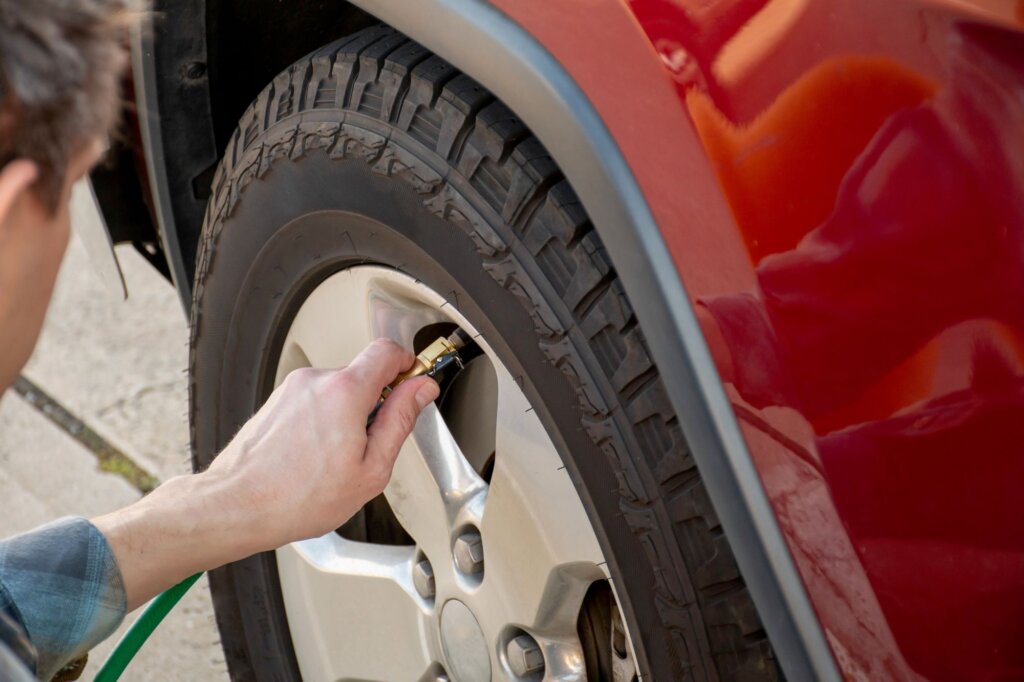You’re driving along when suddenly a light pops up on your dashboard: “Check Tire Pressure.”
It’s easy to either ignore or panic, but this alert is an important safety feature designed to prevent tire-related issues. This guide can walk you through what to do when your car displays this message. Taking quick action can help you avoid more serious problems and keep your ride safe and smooth!
1. Stay Calm and Find a Safe Spot to Pull Over
If the “Check Tire Pressure” light appears while driving, don’t panic. In most cases, it’s not an immediate emergency, but you should address it soon to avoid potential issues. Safely pull over to a nearby parking lot or the side of the road, if possible. Avoid driving long distances with this warning on, as driving with improperly inflated tires can lead to uneven wear, poor handling, and reduced fuel efficiency.

2. Understand the Cause of the Warning
The “Check Tire Pressure” alert is typically triggered by your car’s Tire Pressure Monitoring System (TPMS), which detects when one or more tires are underinflated or overinflated. Common causes to look for include:
- Temperature changes: A drop in outdoor temperature (especially during colder months) can cause tire pressure to decrease.
- Slow leaks: A nail, screw, or other small puncture in a tire can cause gradual pressure loss.
- Time and wear: Over time, tires naturally lose a small amount of air pressure.
When you’ve pulled over in a safe location, check your tires to see if you can locate the cause of the alert. Understanding the potential cause can help you determine whether the situation requires immediate roadside attention or if you are able to drive to the nearest gas station or mechanic.
3. Check the Tire Pressure Yourself
Once you’ve pulled over safely, use a tire pressure gauge to check the air pressure in all four tires, as well as the spare if you have one. Many gas stations have air pumps equipped with gauges, or you can carry a portable gauge for added convenience.
Compare the readings to the recommended tire pressure for your vehicle, which can usually be found:
- In the owner’s manual
- On a sticker posted inside of the driver’s side door
- On the tire itself (though this number is often the maximum PSI and not the recommended amount)
The pressure is typically measured in PSI (pounds per square inch). If a tire is significantly below the recommended PSI, it may need immediate attention.
4. Inflate or Deflate the Tires as Needed
If you discover that a tire is underinflated, you’ll need to add air. Most gas stations have air pumps available, you can use a portable air compressor if you have one, or you can drop by a nearby auto repair shop. Follow these steps to inflate your tires:
- Remove the valve cap on the tire.
- Attach the air pump nozzle to the valve.
- Fill the tire in short bursts, checking the pressure frequently to avoid overinflation.
- Reattach the valve cap once the tire is at the correct PSI.
If a tire is overinflated (less common), you can release some air by pressing the valve stem gently. Be cautious not to let out too much air and recheck the pressure as needed.
5. Inspect Your Tires for Damage
If a tire is significantly underinflated or the light comes back on after adding air, take another moment to inspect your tires for visible damage. Look for:
- Nails, screws, or sharp objects embedded in the tire
- Bulges or cracks in the sidewall
- Uneven or excessive tread wear
If you notice any of these issues, it’s best to visit a tire repair shop or auto service center as soon as possible. A professional can patch punctures, assess the overall condition of your tires, and recommend replacements if necessary.
6. Reset the TPMS Light
After adjusting your tire pressure, the TPMS light may take a few minutes to turn off as the system recalibrates. If it doesn’t turn off automatically, you might need to reset it manually. The process varies depending on your car’s make and model, so refer to your owner’s manual for instructions. In some cases, you may need to drive for a short distance to allow the system to update.
7. Don’t Delay Regular Maintenance
Many tire pressure issues can often be avoided with regular maintenance. Make it a habit to check your tire pressure regularly (at least once a month) and before any long road trips. Rotate your tires about every six months to help distribute the wear and tear, and replace your tires when the tread becomes worn or they reach the end of their lifespan.
Staying proactive about tire care will keep your car running safely, improve fuel efficiency, and extend the life of your tires.
Seeing the “Check Tire Pressure” light while you’re driving may feel inconvenient, but it’s an important feature to alert you to tire issues. Next time the light pops on, you’ll know exactly what to do—because peace of mind is worth the quick stop to check your tires.
